For those of you nice folks that follow me on facebook, you know that I am on it frequently. I mean, I am on it A LOT. I often browse around trying to find the latest trends on equipment, newly discovered fish, what corals are popping up, and what other hobbyists are thinking. I also try to help some folks along the way. As I was looking for topics to write about or to film, I realized that I am looking for topics that are new or interesting to me and to my level of knowledge (which isn’t much) in the hobby. I decided to go against that and to start write for all hobbyists and their level of knowledge in the hobby.
With that said, let’s talk about live rocks today. I know that dry rock is the trending or hip thing to use these days but back in the day, liverock was all we used to help cycle and establish healthy bacteria levels in our tanks. We will get to dry rock in a separate blog down the road. To help me with this article, I reached out to my friend Tom Weibel of Salty Bottom Reef Company, a licensed live rock aquaculture facility, to talk about live rock.
First of all, what is live rock?
“Live rock is simply rock from the ocean that has been introduced into a saltwater aquarium. Along with live sand, it is used in the aquarium due to multiple benefits desired by the saltwater aquarium hobbyist. Live Rock is highly valued in Marine Aquariums not only for the diversity of life it can bring to your tank, but also its function as a superior biological filter that hosts both aerobic and anaerobic nitrifying bacteria required for the nitrogen cycle that processes waste. Live rock becomes the main biological nitrification base or biological filter of a saltwater aquarium. Additionally, live rocks have a stabilizing effect on the water chemistry, in particular on helping to maintain constant pH by the release of calcium carbonate. Lastly, live rock, especially when encrusted with multiple colors of coralline algae, becomes a major decorative element of the aquarium and provides shelter for the inhabitants. It is often used to build caves, arches, overhangs, or other structures in the tank, a practice known as aquascaping.”
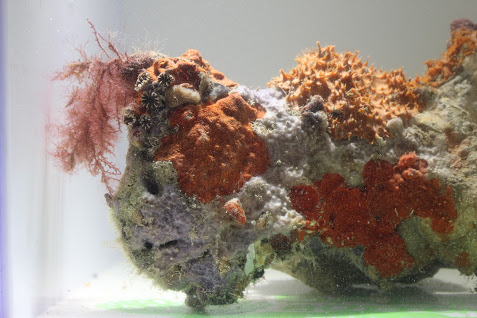
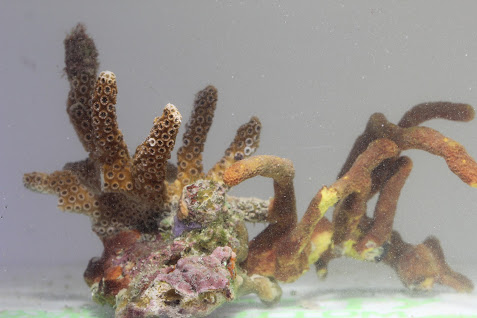
Isn’t collecting liverock illegal? How does this work?
It’s highly illegal. “It is highly regulated, we have to be licensed by NOAA, FWC, and the State Department of Agriculture, because we are technically a farm. Before we harvest we have to alert The National Fisheries and we have to file a ticket with FWC with the amount we harvested. It is crazy, I have a book of licenses in the boat, when I get pulled over I just hand them the book. We (don’t take any actual rocks from the oceans but we) take dry rock, mined from south Florida and place it out on our lease sites. We have 2 1/2 acre sites in the Gulf 12 miles off shore. Then you place the rock and it attracts the creatures.”
That’s very interesting. Because it’s land quarried rocks, I’m thinking that it will look slightly different from the traditional rocks that are found in the gulf of Mexico. Now can you tell me some misunderstandings or misconceptions about the live rocks?
“All the rock that we place has to be visually different than any natural live rock.
The name sometimes leads to misunderstandings, as the “rock” itself is not actually alive, but is made simply from the aragonite skeletons of long dead corals, or other calcareous organisms, which in the ocean form the majority of coral reefs. When taken from the ocean it is usually encrusted with coralline algae and inhabited by a multitude of marine organisms. The many forms of micro and macroscopic marine life that live on and inside of the rock, [which acts] as an ideal habitat, give it the name live rock.”
So tell me the difference in between aquacultured live rocks and live rocks that are naturally found in the ocean.
“Aquacultured Live Rock is essentially dry rock, we use mined ancient reefs that are now part of Florida, that has been placed back into the ocean to create Live Rock. This process can take months or years depending on the amount of life that you want to populate the rock. The biggest difference between Aquacultured and Natural Live Rock is Aquacultured Rock is sustainable and not only does it not hurt the environment, it actually helps. Reefs are created when upland rock is placed on lease sites that are monitored by the National Marine Fishery Service. The sites are selected and surveyed prior to any rock being deployed and they must meet a few criteria. They have to be free of any natural rock, sea grass or other items. Essentially, you have to find an underwater desert and place your rock there. This creates a reef that soon becomes home for many species that otherwise may not have had a home. The pros for Aquacultured Live Rock are it is Eco Friendly and Sustainable, the rock is packed with organisms and as it is usually handled far differently than Indo pacific rock, harvested wet, stored wet and shipped wet. This allows your tank to be fully operational much much faster as you do not have to wait for the dry rock to become live.”

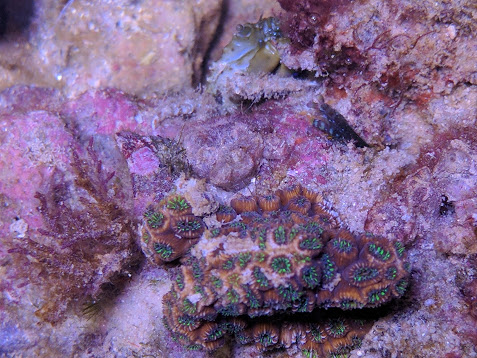
Many hobbyists are going with dry rocks because of potential pests that the live rock can bring. What are your thoughts on that matter?
“On Live Rock there are hitchhikers, these can be both a pro and a con, as many of these are very desirable, however some are not. Where the Live Rock comes from is a very important factor in what hitchhikers it may or may not have. For example, Salty Bottom Reef Co. utilizes leases in the Gulf of Mexico, knowing this you would be able to determine the type of hitchhikers that may come on the rock, for example, since there are no zoas native to that area, you will not be receiving zoa eating nudis. The vast majority of the hitchhikers are beneficial, in one way or another, either as being a source of food, a filter, or simply being beautiful. On the rare occasion that you do get a undesirable hitchhiker they are normally fairly easily removed with traps or even tweezers. I would just say that there is a lot of talk about how hitchhikers are “bad” but in reality, they are what make the tank thrive. I have always used our rock (or rock like ours before I bought the company) and the critters that you don’t even know are there are cleaning your tank and taking care of things for you. When your tank is set up in the same way natural reefs are with a mass of life living in the rock it just seems easier to me to regulate everything. Starting with dry rock you don’t have that extra bit of help. Also nothing is better than taking a flashlight on some fresh Live Rock about an hour or so after the lights go off. It is amazing the things you will see.”
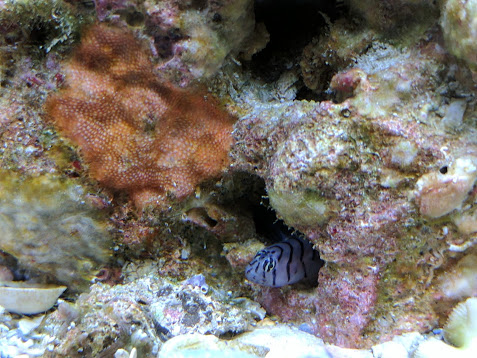
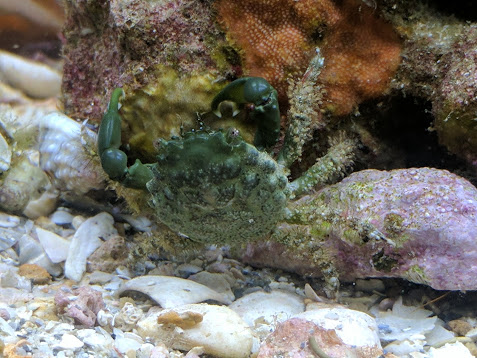
So knowing the location where the rock is from, you can eliminate the potential pests that can live in them. Ideally, if you can, you should set up a small system for observation or with traps. What do you think? I’m against dipping rocks in medicated dips as it defies the purpose of getting a “live rock”.
“To me the point of live rock is the hitchhikers. If you’re afraid of bad ones, simply keep the rock in a separate container for a couple weeks until you know what’s on/in it. A Rubbermaid tub works great for this. I would (use a) powerhead (to aerate the water) and a moderate light, like fluorescent shop lights work well, doesn’t have to be a reef light.”
Well there you go folks. There are a million ways to keep a successful reef and for those of you guys with patience to monitor, on the fence about what to get, and those who want the highly decorated rock all ready to go from the start, liverock is good option to go. Many reputable LFS can tell you the source of these rocks so you know exactly what you are getting and what to expect. Coming from rock farms like Salty Bottom Supply, they are sustainable, attractive, and crawling with desirable life that you want for your aquarium. It also has beneficial bacteria inside already and will cut down your initial cycle time. Something to think about when setting up a new tank or adding more rocks to your already-existing aquariums.
Happy Reefing!









I always find that people don’t know about the periphyton on their rocks. So this may help to explain what changes the rock from dead to live:
What is Periphyton?
Periphyton is what turns your rocks different colors. You know… the white rocks you started with in SW, or the grey rocks (or brown wood) you started with in FW. After several months or years, the rocks become a variety of different colors and textures. Why? Because the periphyton that has grown on it is a mix of different living things, of different colors, and thicknesses. And the important part is: It is LIVING. And the thicker it is, the more natural it is.
That’s right: The colored stuff that has coated your rocks is all living organisms. Sponges, microbes, algae, cyano, biofilms, and of course coralline. After all, “peri” means “around the outside”, and “phyto” means “plant”. Ever slipped while walking on rocks in a stream? That’s probably periphyton that made it slippery. It’s a very thin coating on the rocks, sometimes paper thin.
There is a lot of photosynthetic organisms in periphyton, and this of course means that they need light; but they need nutrients too (ammonia, nitrate, phosphate). And as you might figure, they will be on the illuminated portions of the rocks. And they will grow to intercept food particles in the water, based on the water flow. Just think about how sponges orient their holes for water flow; the micro sponges in periphyton do it too but on a tiny scale.
What about under the rocks, in the dark areas? Well these periphyton don’t get light, so they are primarily filter feeders. So they REALLY grow and position themselves to be able to intercept food particles. And they don’t really need to fight off algae, because algae does not grow in the dark, so they have no need for anti-algae tactics like periphyton in illuminated areas has.
Reef studies have shown that at certain depths, more of the filtering of the water comes from periphyton and benthic algae than comes from the phytoplankton which filters the deeper water. And in streams, almost all the filtering is done by periphyton. So, what you have on rocks that are “mature” or “established” is a well-developed layer of periphyton; and all the things that comes from it.
This is why mandarin fish can eat directly off the rocks of an “established” tank (tons of pods grow in and consume the periphyton), but not on the rocks of a new tank. Or why some animals can lay their eggs on established rocks, but not new ones. Or why established tanks seem to “yo-yo” less than new ones. Even tangs can eat periphyton directly when it’s thick enough. Yes periphyton can also develop on the sand, but since the sand is moved around so much, the periphyton does not get visible like it does on rocks. So thick periphyton on established rocks is your friend. And totally natural too. That’s why there are no pure white rocks in reefs. Keep in mind though I’m not referring to nuisance algae on rocks; I’m only referring to the very-thin layer of coloring that coats the rocks.
But what happens when you “scrub the stuff off your rocks”? Well you remove some of the periphyton, which means you remove some of your natural filter and food producer. What if you take the rocks out of the water and scrub them? Well now you not only remove more of your natural filter and food producer, but the air is going to kill even more of the microscopic sponges in it. And what if you bleach the rocks? Well, goodbye all filtering and food producing for another year. It’s an instant reduction of the natural filtering that the periphyton was providing.
However, what if you just re-arrange the rocks? Well, some of the periphyton that was in the light, now will be in the dark; so this part will die. And some of the periphyton that was in the dark will now be in the light, so it will not be able to out-compete photosynthetic growth and thus will be covered and die too, for a while anyway. And even if the light stays the same, the direction and amount of water flow (and food particles) will change; sponges that were oriented to get food particles from one direction will now starve. So since the light and food supply is cut off, the filtering that the periphyton was providing stops almost immediately, due only to your re-arranging of the rocks.
Starvation takes a little longer. The periphyton organisms won’t die immediately, since they have some energy saved up; but instead, they will wither away over several weeks. So on top of the instant reduction in filtering that you get by just moving the rocks, you get a somewhat stretched-out period of nutrients going back into the water. And after all this, it takes another long period of time for the periphyton to build up to the levels it was at before: 1 to 2 years. Even changing the direction of a powerhead will affect the food particle supply in the area it used to be pointed at.
So a good idea is to try to keep everything the same. Pick your lighting, flow, layout, and try to never move or change anything. In other words, just like the rocks on a reef. It’s a different way of thinking, but you should have a stronger natural filter and food producer because of it.
Hello,
I have a saltwater tank with live rock and various fish. The question is that I have these jelly looking tubes growing off of my rock, they look tabular with a hollow middle. I have never seen these before in my 10 years with this hobby. Any suggestions would be helpful.
Thank you, melody from Pittsburgh, pa.